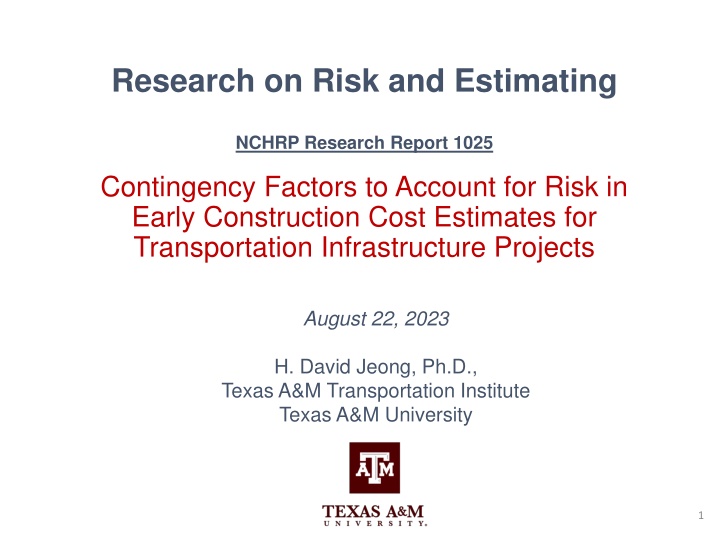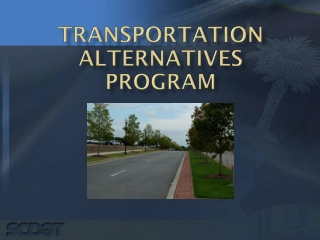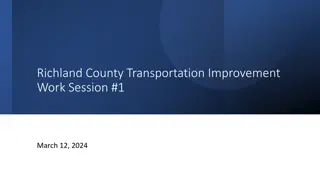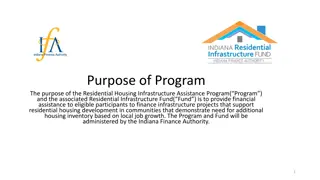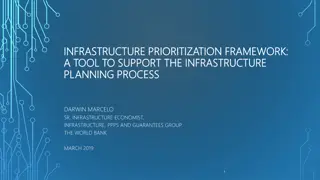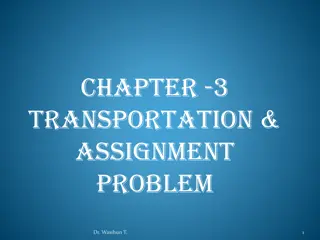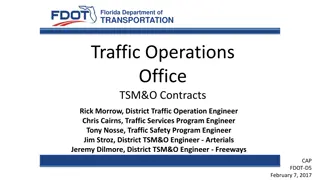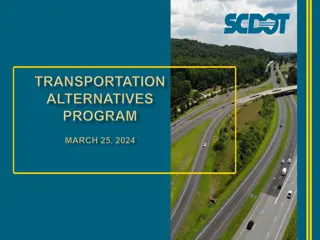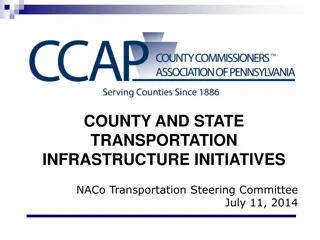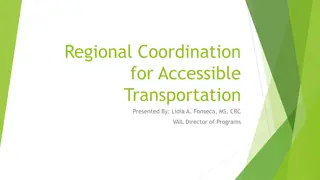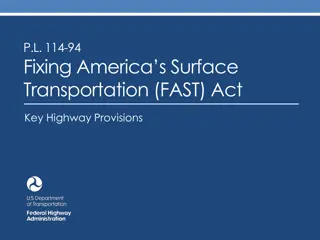Risk Estimation for Transportation Infrastructure Projects
Research Report 1025 focuses on developing early estimates of contingency factors to address construction cost risks in transportation infrastructure projects. The report provides guidance on key concepts, estimation methods, major risks, and approaches for estimating and monitoring construction contingencies, aiming to assist state DOTs and program managers in improving cost certainty during project development.
Download Presentation

Please find below an Image/Link to download the presentation.
The content on the website is provided AS IS for your information and personal use only. It may not be sold, licensed, or shared on other websites without obtaining consent from the author.If you encounter any issues during the download, it is possible that the publisher has removed the file from their server.
You are allowed to download the files provided on this website for personal or commercial use, subject to the condition that they are used lawfully. All files are the property of their respective owners.
The content on the website is provided AS IS for your information and personal use only. It may not be sold, licensed, or shared on other websites without obtaining consent from the author.
E N D
Presentation Transcript
Research on Risk and Estimating NCHRP Research Report 1025 Contingency Factors to Account for Risk in Early Construction Cost Estimates for Transportation Infrastructure Projects August 22, 2023 H. David Jeong, Ph.D., Texas A&M Transportation Institute Texas A&M University 1
NCHRP Research Report 1025: Contingency Factors to Account for Risk in Early Construction Cost Estimates for Transportation Infrastructure Projects https://nap.nationalacademies.org/download/26829 2
Why ? - Construction Cost Certainty ! Scoping Phase Planning &Programming Preliminary Design Final Design Construction $ $ $ Engineer s Estimate Actual Cost Early Estimate Significant variation between early estimate and construction costs may lead to delaying, adding, or cancelling projects. Reallocation of funds or additional funds are needed. Use of contingency factors is a good approach to addressing potential cost risks Inconsistent and inaccurate application of contingency factors is a problem. 3
1. Introduction NCHRP Research Report 1025 A guidebook for developing early estimates of contingency factors for common project-related risks that affect construction costs. The report will be of interest to those at state DOTs who are responsible for developing early construction cost estimates for projects, as well as for those who track program-level construction costs. 4
Report Structure 1. Introduction 2. Key Concepts Construction Contingencies 3. Estimation Methods for Construction Contingencies 4. Major Risks for Construction Contingency Consideration 5. Guidance on Risk-Driven Approach for Estimating Construction Contingencies 6. Guidance on Historical Data-Driven Approach for Estimating Construction Contingencies 7. Guidance on Tracking and Monitoring Construction Contingencies 5
2. Key Concepts Construction Contingencies Key Concepts and Components of Construction Cost Contingency Inconsistencies in DOT manuals and guidelines Inconsistencies in DOT practitioners perceptions (From Survey) FHWA definitions adopted by the research team 6
2. Key Concepts Construction Contingencies Major Elements of Construction Cost Estimate Contingency - Unknown Knowns Early Estimate = Base cost (itemized costs + allowance) + Contingency 7
2. Key Concepts Construction Contingencies Construction Cost Contingency Coverage Risks realized during construction Scope change Minor item allowance Scope creep No. States Alaska California Colorado Connecticut Florida Georgia Idaho Illinois Indiana Iowa Michigan Minnesota Montana Nevada New York North Carolina Ohio Pennsylvania Texas Utah Washington 1 2 3 4 5 6 7 8 9 X X X X X X X X X X X X X 10 11 12 13 14 15 16 17 18 19 20 21 8 *Note: : Included, X: Not included, and : Not specified
2. Key Concepts Construction Contingencies Construction Cost Contingency Definition Construction Cost Contingency Unknown knowns Identified Risks Construction Cost Contingency should not include Allowances (x) Major Scope Change (x)
3. Estimation Methods for Construction Contingencies Construction Contingency Estimating Methods Contingency estimating methods Deterministic approach - Determine a single point estimate. - Appropriate when estimators are familiar Deterministic approach Probabilistic approach with the type of the project from their experience. Fixed percentage Expected value Probabilistic approach Monte-Carlo simulation Sliding scale - Modeling uncertainty through statistical Expert judgment PERT techniques. Parametric estimating - Quantify risk impacts of probability with given project information. 10
3. Estimation Methods for Construction Contingencies Contingency Estimating Methods Fixed Percentage Sliding Scale Expected Value Monte Carlo Simulation No. State Alaska California Colorado Connecticut Florida Georgia Idaho Illinois Indiana Iowa Michigan Minnesota Montana Nevada New York North Carolina Ohio Pennsylvania Texas Utah Washington Total 1 2 3 4 5 6 7 8 9 10 11 12 13 14 15 16 17 18 19 20 21 A review of cost estimating manuals and risk management guides 16 10 5 5 24% 76% 48% 24% 11
3. Estimation Methods for Construction Contingencies Deterministic approach Fixed percentage of base cost Sliding Scale Expert Judgment - The simplest method. - A pre-determined percentage of the base cost. - A range of percentages. - Different ranges for different project conditions - Use estimator s personal experience and judgement. - Reflect project specific characteristics. Project development stage Feasibility Functional Preliminary At ROW Final preliminary Contingency for roadway portion +55% +45% +35% +25% +15% Contingency for structure portion +15% +15% +10% +10% +5% Define decision problems Recruit experts Collect expert judgement Analyze expert judgement (Pros) Simple, straightforward, and available when useful project information is insufficient. (Cons) Accuracy is dependent upon cost estimator s experience and expertise. 12
3. Estimation Methods for Construction Contingencies Probabilistic approach Expected value Occurrence (%) (A) Impacts ($) (B) Contingency ($) (A)*(B) Risks Known Hazardous Substance 10 125,000 12,500 - Identify project-specific risks and evaluate the probability and impact of the identified risks. - Require detail project information. Coordination with Railroad Agencies Treatment of Water Discharged from Site Total 10 50,000 5,000 3 400,000 12,000 29,500 Monte Carlo simulation - A sophisticated computer-based probabilistic method. - Provide more realistic contingencies through a range of possible values. (Pros) Can reflect project-specific characteristics and conduct more flexible contingency estimates. (Cons) Requires more time and effort to perform it.
4. Major Risks for Construction Contingency Consideration Major Risks for Construction Contingency Estimating Top risk identification process 1. Analysis of DOT risk checklists and risk registers 2. Find risks through discussions with DOTs 3. Assess risk occurrences and impact magnitude 4. Prioritize top 12 risks The list of 23 risks Determined top 12 risks 14
4. Major Risks for Construction Contingency Consideration Top 12 Major Risks 23 risks for contingency estimating Prioritized Top 12 risks Utility issues Unexpected geotechnical issues Constructability issues Railroad involvement Late changes requested by stakeholders Errors in cost estimating Maintenance of traffic/work zone traffic control Unknown or change in current asset conditions Unexpected archeological or historic findings Endangered/protected species encountered during construction Issues with new materials, technologies, and methods Coordination with other projects Poor or incomplete project scope definition during the scoping phase Design changes Contractor availability and competition Market conditions Project duration-related issues Funding availability Hazardous materials encountered during construction Coordination with government agencies Surveys late or in error Political risks Unanticipated noise impacts and noise mitigation Ranking Risk 1 Utility issues Poor or incomplete project scope definition during the scoping phase 2 3 4 5 6 7 8 9 10 11 12 Unexpected geotechnical issues Design changes Constructability issues Contractor availability and competition Railroad involvement Market conditions Late changes requested by stakeholders Project duration-related issues Errors in cost estimating Funding availability 15
5. Guidance on Risk-Driven Approach for Estimating Construction Contingencies Workflow of Estimating Contingency for High Priority risks 1. Determine project characteristics, conditions, and environments No Is there any trigger? Stop Yes 3. Conduct qualitative assessment 2. Contact subject matter experts (SMEs) No Is this risk significant? Stop Help more thorough and comprehensive Yes 4. Gather information & data from SMEs risk considerations. Can reflect project characteristics rather 5. Determine the probability and cost impact of the risk than simply apply pre-defined 6. (Optional) Select a response strategy & determine residual contingency percentages Output the contingency amount for the risk 16
5. Guidance on Risk-Driven Approach for Estimating Construction Contingencies Step 1 1. Determine project characteristics, conditions, and environments No Is there any trigger? Stop Yes 3. Conduct qualitative assessment 2. Contact subject matter experts (SMEs) No Is this risk significant? Stop Step 1:Determine project characteristics, conditions, and environments Yes 4. Gather information & data from SMEs - Gather key project information from 5. Determine the probability and cost impact of the risk scoping reports, including characteristics, conditions, and environments. 6. (Optional) Select a response strategy & determine residual contingency - Identify the triggers for each of the top risks. Output the contingency amount for the risk
5. Guidance on Risk-Driven Approach for Estimating Construction Contingencies Step 2 1. Determine project characteristics, conditions, and environments No Is there any trigger? Stop Yes 3. Conduct qualitative assessment 2. Contact subject matter experts (SMEs) No Is this risk significant? Stop Step 2: Contact subject matter experts (SMEs) Yes 4. Gather information & data from SMEs - SMEs can provide valuable input and 5. Determine the probability and cost impact of the risk help validate project cost estimates. - Early cost estimators can contact 6. (Optional) Select a response strategy & determine residual contingency relevant SMEs to get more information on the risks. Output the contingency amount for the risk 18
5. Guidance on Risk-Driven Approach for Estimating Construction Contingencies Step 3 1. Determine project characteristics, conditions, and environments No Is there any trigger? Stop Yes 3. Conduct qualitative assessment 2. Contact subject matter experts (SMEs) No Is this risk significant? Stop Step 3:Conduct qualitative assessment Yes 4. Gather information & data from SMEs - Evaluate the risk s significance on the project. 5. Determine the probability and cost impact of the risk - Assign scores from 1 to 5 to the risks 6. (Optional) Select a response strategy & determine residual contingency in terms of occurrence probability and their impacts. Output the contingency amount for the risk 19
5. Guidance on Risk-Driven Approach for Estimating Construction Contingencies Step 4 1. Determine project characteristics, conditions, and environments No Is there any trigger? Stop Yes 3. Conduct qualitative assessment 2. Contact subject matter experts (SMEs) No Is this risk significant? Stop Step 4:Gather information & data from SMEs Yes 4. Gather information & data from SMEs - Gather information and data from 5. Determine the probability and cost impact of the risk SMEs that can serve as a reference for early cost estimators. 6. (Optional) Select a response strategy & determine residual contingency Output the contingency amount for the risk 20
5. Guidance on Risk-Driven Approach for Estimating Construction Contingencies Step 5 and Step 6 1. Determine project characteristics, conditions, and environments No Is there any trigger? Stop Yes 3. Conduct qualitative assessment 2. Contact subject matter experts (SMEs) No Step 5:Determine the probability and cost impact of the risks Is this risk significant? Stop Yes - Estimate the risk s impact (optimistic (O), 4. Gather information & data from SMEs most likely (M), and pessimistic (P)). 5. Determine the probability and cost impact of the risk - The average impact: I = (O+4M+P)/6. - Contingency amount = Pr x I 6. (Optional) Select a response strategy & determine residual contingency Step 6:(Optional) Select a response strategy & determine residual contingency Output the contingency amount for the risk 21
6. Guidance on Historical Data-Driven Approach for Estimating Construction Contingencies Overall Process of Historical Data-Driven Approach 2. Data Cleaning and Pre- processing 3. Data Analysis and Project Characterization 1. Historical Cost Data Collection 4. Model Development 5. Apply Model to Projects - Use historical digital data for performing a construction contingency estimation. - Allow cost estimators to have confidence in their contingency numbers for a new project. 22
6. Guidance on Historical Data-Driven Approach for Estimating Construction Contingencies Work Tasks for Historical Data-Driven Approach 2. Data Cleaning and Pre- processing 3. Data Analysis and Project Characterization 1. Historical Cost Data Collection 4. Model Development 5. Apply Model to Projects <Cost data for data collection> Data collection and cleaning Cost type Ideal data attributes Base estimate (major work items + allowance) Construction contingency The entire list of pay items with their quantities and unit prices The entire list of actual pay items with their quantities and unit prices Change orders - Gather historical data over the Early estimate project development phases. - Filter out projects that went Engineer s estimate through major scope changes. Final construction cost 23
6. Guidance on Historical Data-Driven Approach for Estimating Construction Contingencies Work Tasks for Historical Data-Driven Approach 2. Data Cleaning and Pre- processing 3. Data Analysis and Project Characterization 1. Historical Cost Data Collection 4. Model Development 5. Apply Model to Projects RFB: The ratio of the final construction cost to the base cost estimate ??? (%) = (????? ???????????? ???? ?? ? ? ??? ?? ??????? ???? ???? ???????? ?? ? ? ??????? ? ??? 1) ? 100 Classify project based on characteristics Ex) Project type: New construction, Reconstruction, Resurfacing, Rehabilitation, and Relocation. Project size: Small sized, Mid sized, and Large sized. 24
6. Guidance on Historical Data-Driven Approach for Estimating Construction Contingencies Work Tasks for Historical Data-Driven Approach 2. Data Cleaning and Pre- processing 3. Data Analysis and Project Characterization 1. Historical Cost Data Collection 4. Model Development 5. Apply Model to Projects Contingency range estimation - Perform statistical analysis. - Probability distribution fitting. <PDF> - Develop probability density functions (PDF) and cumulative distribution functions (CDF). <CDF> 25
6. Guidance on Historical Data-Driven Approach for Estimating Construction Contingencies Case Study - CDFs of six project types. - Cumulative probability refers to certainty about a given RFB. - RFB can be a percentage of base cost. RFB 30% Types 10% 50% Roadway - new construction 0.022 0.638 0.93 0.177 Roadway reconstruction 0.688 0.905 0.697 0.966 Roadway resurfacing 0.101 Roadway rehabilitation 0.132 0.652 0.888 Bridge replacement 0.136 0.677 0.928 Bridge rehabilitation 0.091 0.670 0.927 26
6. Guidance on Historical Data-Driven Approach for Estimating Construction Contingencies Case Study Applications (Incorporate CDF into sliding scales) : Convert a construction contingency amount to the percentage of the base estimate. : Check cumulative probability from CDF curves to ensure the certainty of construction contingency. 27
6. Guidance on Historical Data-Driven Approach for Estimating Construction Contingencies Use of two approaches RISK RESPONSE (SCOPING PHASE) Residual Risk Assessment Risk response Contingency after risk response ID. Risk control method Probability of occurrence after risk response Construction cost impact of the action Responsibility Action to control risk Expective value Subsurface Utility Engineering (SUE) Survey R01 Transfer Utility Engineer $ 14,000.00 75% $ 317,500.00 Subsurface Utility Engineering (SUE) Survey R02 Accept Project Engineer $ 4,500.00 82% $ 112,066.67 Verification: Historical data-driven approach Estimation: Risk-driven approach - Conduct risk identification and - Backcheck the amounts from risk- estimate their impacts on driven estimating. construction contingency. - Evaluate certainty for verification. 28
7. Guidance on Tracking and Monitoring Construction Contingencies Construction Contingencies Tracking and Monitoring Major milestone meetings for tracking and monitoring (a) (b) (c) (d) (e) End of project scoping Construction completion 30% design 60% design 90% design 29
7. Guidance on Tracking and Monitoring Construction Contingencies Iterative Process for Tracking and Monitoring Construction Contingencies Construction contingency monitoring and tracking Scoping 30% design 60% design 90% design End of construction Before risk response After risk response Before risk response After risk response Before risk response After risk response Before risk response After risk response Actual paid amounts R01 R02 R03 R04 R05 R06 R07 R08 R09 R10 R11 R12 150,000 20,000 50,000 200,000 10,000 359,833 123,000 122,542 123,750 103,133 210,750 84,858 30,000 20,000 24,000 19,200 20,800 317,500 112,067 116,775 116,875 92,213 187,333 79,867 30,000 20,000 22,000 18,000 20,000 304,800 102,500 111,008 104,500 84,933 175,625 71,880 28,800 20,000 20,000 17,200 18,000 296,333 102,500 100,917 96,250 80,080 168,600 69,883 26,000 18,800 18,000 16,000 16,000 254,000 88,833 89,383 85,250 72,800 152,208 64,892 24,000 16,000 16,000 16,000 14,800 254,000 82,000 86,500 82,500 72,800 140,500 57,903 23,200 14,800 14,800 14,000 14,000 190,500 65,600 74,967 70,125 60,667 124,108 50,915 22,000 14,000 14,000 12,000 12,800 169,333 61,500 69,200 59,125 50,960 117,083 47,920 20,000 12,800 12,800 12,000 12,000 2,501 8,000 12,000 11,000 10,000 9,000 8,000 1400000 1200000 1000000 800000 600000 400000 200000 0 Before response After response Before response After response Before response After response Before response After response Actual paid amounts . Scoping 30% design 60% design 90% design End of construction R01 R02 R03 R04 R05 R06 R07 R08 R09 R10 R11 R12 <MS Excel tool interface for contingency tracking and monitoring> 30
7. Guidance on Tracking and Monitoring Construction Contingencies Continuous Improvement of Construction Contingency Estimating Process <Process for feedback loop for construction contingency estimating> 31
Feedback to djeong@tamu.edu 32
